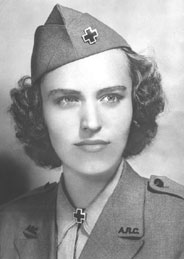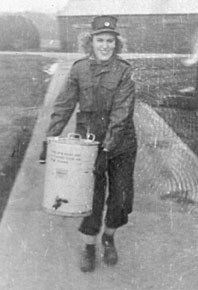Today, June 6th, is the 68th anniversary of D-Day, the day in 1944 when American troops landed in Normandy along with other Allied forces during World War II. It’s a day to remember the contributions of countless men and women who served and represented the country overseas during a harsh time of war.
 The excerpts below tell an amazing story about a Red Cross worker named Elizabeth Richardson. You can head over to the National Archives page to read her whole story (which I highly recommend). Elizabeth was a Red Cross volunteer who helped bring comfort and hope to the troops overseas. She represented a piece of home for the soldiers and truly embodied the Red Cross mission.
The excerpts below tell an amazing story about a Red Cross worker named Elizabeth Richardson. You can head over to the National Archives page to read her whole story (which I highly recommend). Elizabeth was a Red Cross volunteer who helped bring comfort and hope to the troops overseas. She represented a piece of home for the soldiers and truly embodied the Red Cross mission.
The American Red Cross had responsibility for lifting the morale and spirit of these homesick GIs, primarily by operating recreation clubs in the large cities. By 1944, however, Yanks were stationed all over the British Isles, most at a distance from cities with clubs. The Red Cross’s response to such massive troop dispersion was the Clubmobile, a single-decker bus fitted with coffee and doughnut-making equipment.
Clubmobiles also carried chewing gum, cigarettes, magazines, newspapers, a phonograph, and records. A British driver piloted the large vehicle as it rattled through village streets and down narrow muddy lanes. But the most important contents of each Clubmobile, even more so than coffee and doughnuts, were the three Red Cross women inside, always called “girls.” They were the stars of the traveling show. As one Clubmobiler later wrote: “Doughnuts and coffee were our props.”
From the thousands of hours they spent with GIs, Clubmobile women came to know far more about the men and the war than all but the small percentage of those who actually experienced combat. From her Clubmobile base in England, Margaret Gearhart wrote her parents: “Believe me, Mom and Dad, we Red Cross have seen more of this war than anyone—and what we’ve seen and heard could make an excellent book. We feel the spirit and soul of the war.”
Liz and her colleagues were not warriors and usually stayed far away from the front lines. The work they did was traditionally defined as “women’s”: they cooked, cleaned up, and waited on men. Yet these women did essential war service that included demanding physical labor and stressful emotional costs. Their jobs required sophisticated organizational skills and superb interpersonal relations. And they carried out their duties in a foreign culture away from home with limited resources and scant administrative support. Their experience, maturity, and education gave them a self-awareness and understanding of the job they were doing. They saw the surface contradictions between their mundane chores of serving doughnuts and coffee and their college educations and between their image as “girls” and their work as sophisticated and talented women.
Read more about Elizabeth at the National Archives website.
All images in this post are credited to the National Archives. See their original credits here.

